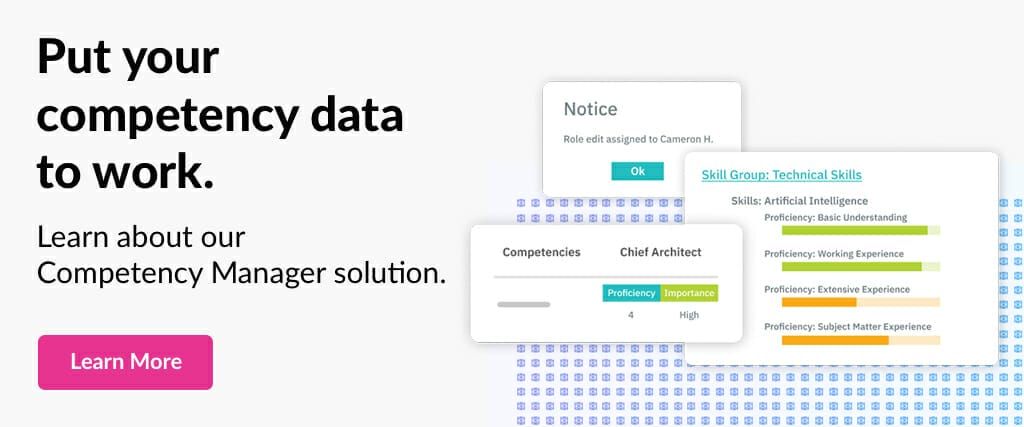Why Your Hiring Freeze Shouldn’t Scare You

Why Your Hiring Freeze Shouldn’t Scare You
Due to hiring freezes, a large number of companies have been abruptly limited to their existing talent pools to staff projects and fill skill gaps. However, we don’t think that should scare you. Instead, if you focus your energy on optimizing your existing workforce, you can overcome these obstacles and set yourself up for success in the long-run.
In this article, we’ll take a closer look at the problems companies are facing due to the hiring freeze, and how we can overcome them with best practices, namely, effective competency management and succession planning, that will prepare you for any circumstance.
Let’s dive right in.
Meeting changing business needs
Many businesses are trying to make the most out of their current workforce to remain competitive and increase productivity by making sure they have allocated resources in the most efficient way. When you think about it, this sounds like a problem all businesses want to solve, right? – regardless of the economic climate.
So how can companies always have a more efficient workforce? The first step is to understand your workforce – their experiences, their preferences, their skills and their competencies so you have the data needed to optimize your workforce operations.
There can be a lot that goes into proper competency management and the reality is that today, many companies have done a poor job at understanding their job and skill architecture — job families, job roles, and the skills that make up those roles. Depending on if a business has done this groundwork already, they also may not have a system to leverage the information into actionable outcomes. But have no fear, both scenarios are possible, and luckily when done right will set you up for long-term success.
What an efficient workforce looks like
Before we discuss how to get you through the situation you are in today, let’s briefly discuss what the desired outcome is. We already stated that we want an efficient workforce but what do we get when that is obtained. Here’s what it looks like:
- You have defined the skills that are required for each role, and you understand which skills (technical and soft) every employee possesses.
- You are able to understand who at your company has a skill or set of skills to join a team, project or change roles to meet demands.
- You have a talent pool of employees ready to be selected from.
- You understand which skills your company lacks, and you know how to develop those competencies in-house, so you remain competitive and productive.
- You know which employees have the aptitude, desire, and experience to join a team, project or change roles, and they have a transparent career path to get there.
That all sounds like an ideal scenario, right? It is and it is possible to have that information at your fingertips. But, if you don’t have access to that information now or have the technology to make that all possible, how do you get out of the situation you are in today?
How to manage workforce competencies to combat a hiring freeze
To get ahead of this issue, HR leadership needs to create and implement a proper competency management strategy to combat talent shortfall due to a hiring freeze.
Here are some of the components of a competency management strategy that works:
Conduct a skills audit
Assess the exact skills gap within the organization in light of downsizing measures. This can be done by taking a closer look at each employee’s skill set and then comparing that to the required skill standard for the role(s) they’re required to fill. Creating a realistic skill gap chart that shows when (at which stage of the product life cycle) and where (in which department) certain employees can potentially be assigned to fill required roles.
Implement proactive succession planning
Create a succession plan or leverage your existing one to establish talent pools of employees to fill critical roles and skills of your business. From there you can begin to assess who is a good fit to fill any gaps you might have.
Provide feedback and development resources
Assess the performance of employees and provide real-time feedback. This lets employees know which competency to put more work into and to what extent they need to upskill themselves to take on added responsibility or fill existing skill gaps. Provide them access to development resources and training material to get started.
Manage your human resources the right way during a hiring freeze
This approach to competency management is a sure-fire way to maintain the profitability and internal stability of your company during a crisis such as the COVID-19 pandemic. However, this is not a short-term approach designed to reduce the financial impact on a company during a hiring freeze.
Active competency management and succession planning is beneficial at any point during a company’s lifetime and will prepare you for future — no matter the situation.
Internal Recruitment in Your Organization
For many years, HR has relied on sourcing external candidates to fill job openings within their organization.However, we are in a different reality today than we were even two months ago. While hiring plans are placed on hold in the current pandemic, organizational skills gaps still exist. In this uncertain environment, many organizations are looking towards internal recruitment to address their needs.
Taking the Right Approach to Developing Critical Skills
Gartner’s 2020 Future of HR Survey names building critical skills as the #1 priority – together with addressing internal skills gaps. To identify the skills your organization needs, Gartner recommends a ‘’market driven, predictive approach’’. This requires both an understanding of the trends in your specific sector, together with a skills audit to gain an accurate picture of the skills your business needs to grow and remain competitive.
Getting Started with a Competency-Based Skills Audit
A competency-based skills audit helps establish a clear understanding of the skills available and required for each role, and unlocks the potential for growth, development and mobility already available in your company.




